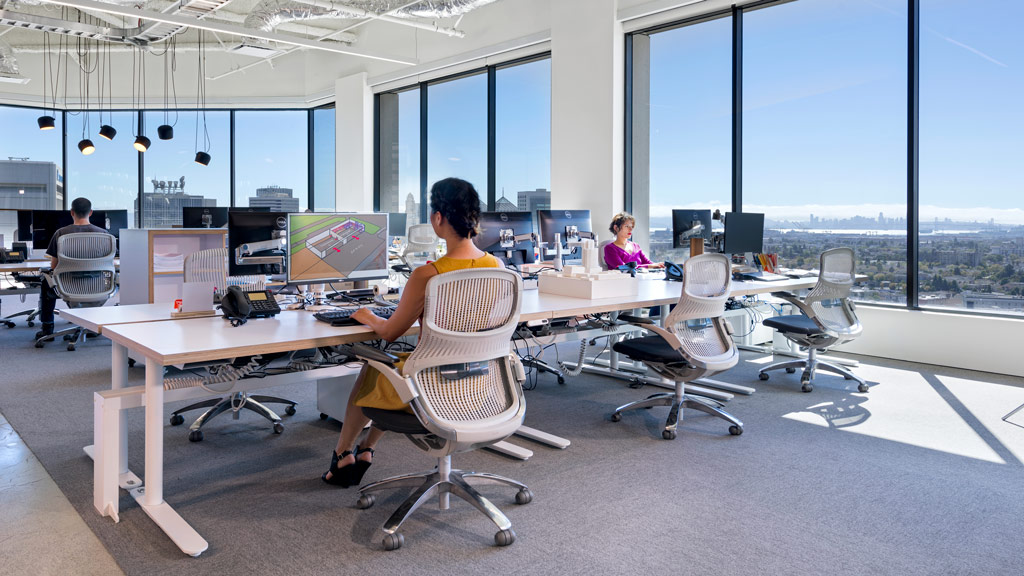What Happens When We Return to the Workplace?
April 03, 2020 | By Janet Pogue McLaurin
Editor’s Note: This post is part of our ongoing exploration of how design is responding to the COVID-19 pandemic.
The coronavirus has turned everything upside down. But, now that we’re starting to get the hang of working from home, our clients are beginning to wonder how they can prepare to bring people back into the office when the crisis subsides.
We know from new Gensler Research Institute workplace data that a well-designed workplace is still the place that people want to be. In the U.S. Workplace Survey 2020, we asked that very question – posing the options between home, the company’s workplace, a coworking space, or coffee shop. Unquestionably, the office was people’s preferred place to work, as long as it’s designed to support their work.
However, before we can ask people to return to the office, we’ve got to make sure they feel safe, healthy, and valued in their workplace. And, while it’s too early to understand the full extent of the new skills and habits we’re developing while working en masse from home, it’s not too early to start planning for how we can return hundreds of thousands of people to the workplace once the quarantines end. Here are some thoughts on the first steps companies can take in the short term.
Planning for the Near Now
Keep your distance. Unless people are wearing face masks, the six-foot social distancing rule should apply in the physical workspace until there is a COVID-19 vaccine and the coronavirus is no longer a health threat to employees. During the interim, employers should remove excess chairs in conference rooms with more than 10 seats. Spread out collaboration seating, so people are spaced further apart. And encourage people to collaborate virtually whenever possible.
De-densify workstations. This might be a challenge in areas where desk spacing is tight, such as some open benching layouts. In situations where existing desk spacing is less than 6 feet apart, consider using every other desk to create a buffer for each person. This could be achieved by assigning some people to working from home or temporarily locating them in other areas. It’s ideal to space employees so they don’t face each other. Consider adding partitions for sit/stand desks that are attached to the desktop and move up and down with the desktop. The goal is to block potentially harmful viruses that can be transmitted by talking, coughing, or sneezing. It’s also preferable to avoid situations where one employee is standing while another is seated within the same 6-foot bubble.
Rethink dynamic and unassigned seating. Upon returning to the office, consider assigning what were formerly shared desks to individuals for a full day or a week, and then make sure they are disinfected before a new person uses the work setting.
Limit tech sharing. To avoid disease transmission, it’s best to provide technology and accessories (such as a mouse, keyboard, or headset) to each individual. These devices are touched throughout the day and are best not shared without disinfecting between uses.
Ramp up cleaning protocols. Employee health depends on a safe and clean work environment. Organizations should implement professional cleaning protocols not only for workstations, but for conference rooms, collaborative areas, cafes, reception desks, and other common areas at regular intervals throughout the day. Employers should provide disinfectant wipes and hand sanitizers throughout the office – and especially in shared areas. If workers maintain a clean and uncluttered desk, the professionals’ job will only be more effective.
Upgrade air filtration systems. The air we breathe is also a shared resource, so invest in air-cleaning systems to protect collaborative environments. Consider installing state-of-the-art air purification and sanitization systems. Many of these systems display real-time air quality measurements on digital screens to keep employees informed, and it will serve as a continuous disinfectant, improving air quality by reducing airborne and surface contaminants like viruses, bacteria, germs, VOCs, smoke, and other allergens.
Practice good hygiene. Reinforce good hygiene practices with well-stocked restrooms that have touchless soap and anti-viral cleaning supplies. Employers should also install plenty of hands-free dispensers with sanitizer that contains at least 60−95% alcohol in lobbies, conference rooms, and lounges. No-touch garbage and recycling receptacles are preferable. Also, door pulls, badge readers, and shared common areas should be disinfected throughout the day.
Learn from healthcare. Manufacturers are integrating new touchless features in interior design elements including touchless faucets, automated window shades, and motion-sensor or voice-activated door hardware. Consider adding these features, especially in building lobbies, reception desks, and shared common areas. Utilize materials which are smooth, easy to wipe down and hold up to frequent deep cleanings, especially in high-traffic areas.
Empower your people. Consider how employees will feel when they prepare to return to the office. Instead of mandating that everyone come back at once, consider offering the option for people to do it in waves. This may not only provide the necessary social distancing, but it would also allow employees a greater sense of control over their health.
Be open to new ways of working. The longer we work from home in large numbers, the more new habits and new ways of working will begin to take shape. We will have discovered different ways to collaborate virtually, which may likely continue when we return to the office. Workflows and communication might improve. We should embrace these changes and let them flourish.
We all expect the coronavirus pandemic will cause major shifts in how we experience the world. So, when this crisis ends, we may well discover there have been fundamental changes in the way we work and in workplace design. But we know the workplace still matters. Building community, reinforcing our organization’s culture, and strengthening relationships with colleagues is still what the workplace is all about.
For media inquiries, email .

